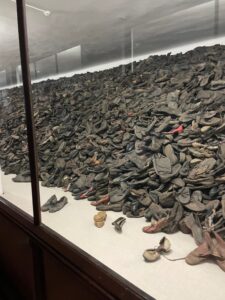On 21st March, four Sixth Formers – Madeleine, Olivia, Leo and James – who all study History at A Level went for a one-day trip to Poland, with the Holocaust Educational Trust, visiting two of the largest and most infamous concentration camps: Auschwitz-Birkenau.
It was a long day, both physically and mentally, but the trip was very memorable and a day the students will never forget.
The day began at 2:30 am, as we woke up to meet at the airport by 4:30. We arrived in Krakow, Poland at 10:00am and began the trip in the city of Oświęcim (most commonly known as Auschwitz in German), an area in southern Poland. Known to have the largest Jewish community in Poland, Oświęcim is home to The Great Synagogue, the first destination of our journey. The Great Synagogue was, until World War II, the largest Synagogue in Europe, even attracting visitors such as monarchs, including Franza Josef I of Austria. However, during the occupation of Poland in 1939, it was destroyed. We visited the memorial surrounding the Synagogue, learning about its origins and the groups which lived around it. The aim of this first destination was to understand the lives of Jews before the war and the dynamics of their community before it was disrupted by the vehemence of the Nazi regime.

After that, we went to Auschwitz 1, the first camp in Poland which is considered the main camp, housing the majority of victims. We were toured around using headphones, going through barracks which had been converted to museums highlighting different topics. We learnt about specific case studies, viewing images of prisoners and relating to their lives before the Holocaust, reflecting and sympathising with their experiences there. From looking at their personal belongings, to viewing the Book of Names (a collection of the names of the victims which had been organised by the country of Israel just after WW2), it was very difficult to comprehend that we were walking where some took their last steps.
Connected by large railway, Auschwitz II-Birkenau was the camp for labour, focusing on agriculture and livestock. However, the camp combined two functions; hard labour and extermination. Personally, this was the hardest part of the journeys; it truly encapsulated what life was like for those taken away from their ordinary lives. The size of the camp was astronomical, and was shocking how much land it covered, as it was the largest concentration camp during the Nazi regime, killing more than 1.5 million between 1940 and 1945.
What was the reason for our visit?
Our one day trip held more significance than one can comprehend. We went in order to acquire a proper sense of the place that has become the symbol of the Holocaust, commiting crimes against ordinary people. Auschwitz is more than a tourist destination, it’s terror and fear but also reflection and hope.
Fortunately, on our trip we were accompanied by a guest speaker, a Rabbi from London, who said that “there is always hope for tomorrow, and you can do anything starting today.”
We went to Auschwitz in order to reflect on the lives lost, understanding that those who died are consumed within the large death tolls, allowing us to forget that these people are individuals too. As emotional as the day was, it makes you question how we can use the past to benefit the future, and as George Santayana said “Those who cannot repeat the past are condemned to repeat it,” showing the importance of seeing a place like Auschwitz.





Leave a Reply